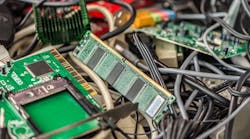Component obsolescence has been a thorn in the side of electronics purchasers for decades, but some insiders say it is becoming more acute because of the consolidation in the electronics supply base, especially in semiconductors.
Consolidation is contributing to an increased rate of obsolescence, says Kristi Syndikus, vice president, global business services, at Celestica, a Toronto-based electronics manufacturing services provider. “Over the past 18 months, Celestica has observed a 15% increase in the number of end-of-life (EOL) notifications from its component suppliers,” she says.
“The data suggests that we are getting waves of notifications when suppliers reevaluate their product portfolios to realign their market strategies,” says Syndikus.
When an electronics supplier acquires another component supplier, the newly merged company often discontinues some of the product lines of the acquired company to eliminate product redundancy.
Jim Feldhan, president of Semico Research, says it’s impossible to say with absolute certainty that obsolescence has increased because of consolidation, but “it would make a lot sense” if it has.
A higher rate of obsolescence may occur when large suppliers are involved in a merger. For example, Freescale merged with NXP and then last October Qualcomm purchased NXP for $39 billion, the biggest acquisition ever in the semiconductor industry.
“You now have three very broad-based companies under one roof and there is apparently a lot of [product] overlap,” says Feldhan. To make the company more efficient, “it makes sense to look at the product lines and decide which ones to discontinue, and push customers to the products that have the best features,” he says. “That would lead them to discontinue to invest in a particular product family and start obsoleting parts.”
Wider Implications
While obsolescence often impacts industries that have long product life cycles—for example, medical, communications, defense, and aerospace—now it could also affect products with short life cycles such as smartphones and consumer electronics equipment. Such products are always being updated and redesigned by OEMs.
With consolidation, electronics OEMs “could run into the situation where there are fewer options,” says Feldhan. “Before, you could buy a certain chip from Freescale, NXP, and Qualcomm, and now you can buy from just one company.”
“If you are building communication switches that have a part that is going to be obsolete, you’re going to have to carry inventory that maybe you would not have had to carry if those companies had still been in business as independent entities,” says Feldhan. Now, companies must be more careful in their planning and stocking of parts so they can maintain products in the field for one or two decades.
It also presents an issue for OEM’s and EMS providers, according to Celestica’s Syndikus.
“Obsolescence for an EMS provider can be inherently more difficult because we can have a variety of customers using the same component with very different product life cycles and market applications, which will drive different strategies for managing the change,” she says.
Celestica looks at every EOL notification from its supply base uniquely and works directly with OEM customers on a plan to manage the business needs, Syndikus says.
Celestica has a supplier process change notification (PCN) process in which all of the EMS provider’s component manufacturers are required to notify Celestica a minimum of 12 months in advance of any process change, including EOL notices. That process helps Celestica work with its OEM customers on strategies to make sure there is supply continuity for the balance of the product life cycle.
Syndikus says Celestica uses a variety of strategies to manage obsolescence including die-banking and last-time-buys, which can be done directly with the component supplier or by using a distribution partner.
New Tools Required
Some electronics manufacturers have developed obsolescence strategies involving homegrown software tools and electronics distributors.
Denis Secher, senior director of global component engineering at EMS provider Sanmina, says his company has developed predictive tools that enable the EMS provider “to see trends in semiconductor components a few years out.”
Sanmina reviews a customer’s approved vendor lists (AVL) and bills of materials (BOMs) for new products and “we let them know about components we see having risk of obsolescence prior to product launch,” says Secher. “Customers often redesign the product using different chipsets based on the information we provide.”
Sanmina has also created “preferred partnerships with selected distributors,” says Secher, where the distributors help Sanmina manage component obsolescence.
Sanmina requires its suppliers to give the company notification at least six months before last order dates. “But this is not always the case,” says Secher. “Having a distributor that can quickly identify components available in volume is key when we have severe component shortages.” Distributors also help Sanmina manage its EOL component excess inventories as well, he says.
Jabil Circuit, an EMS provided based in St. Petersburg, Fla., uses its InControl system to help manage product obsolescence, says Graham Scott, senior director, global commodity management, for Jabil.
InControl is a home-grown risk-management tool. One of its functions is to measure the risk of components going obsolete and keep track of EOL notices that suppliers issue.
“Jabil extracts data as it relates to obsolescence from third-party providers and directly from the manufacturers,” says Scott. “We aggregate all of the content and provide feedback such as risk and alternate supply solutions from our InControl platform.”
He adds that Jabil’s global commodity managers and supplier-relationship management teams work with suppliers to assess their component strategies and roadmaps to get an idea on how long suppliers plan to continue making a part.










